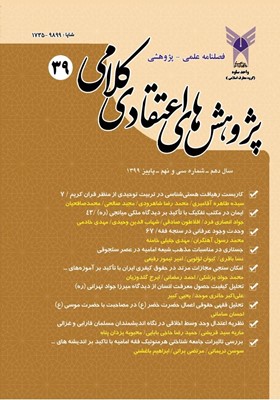جستاری در مناسبات مذهب شیعه امامیه در عصر سلجوقی
محورهای موضوعی : Islamic theology
1 - محلات
کلید واژه: مناسبات, شیعه ی امامیه, حاکمان سلجوقی, مذهب, وزیران شیعی,
چکیده مقاله :
یافته های پژوهش حاکی از آن است که، شيعيان امامى مذهب كه در دورهى سيطره خاندان بويه از آسايش نسبى و اقتدار حكومتى برخوردار بودند، در پى يورش سلجوقيان سنى به بغداد و بر افتادن حاكميت بویيان، دوران سختى را تجربه كردند. سلجوقيان، آنان را از مناصب ادارى راندند؛ پيشواى دينى آنان شيخ طوسى مجبور به ترك بغداد شد و در پى سركوب شورش بساسيرى شيعيان ساكن شهر كرخ، مورد حمله سنيان قرار گرفتند. اما اين وضع پايدار نماند و در طى سلطنت سلجوقيان، شيعيان به تدريج مواضع قدرت را مجدداً اشغال كردند. در اين پژوهش با اشاره به وجود اميران و وزيران شيعى مذهب در ايران از برخورد متقابل شیعه و دستگاه خلافت، آگاهی از فعالیت ها و پیشرفت های علمی و فرهنگی و چگونگی حضور شیعیان در امورات مهم دولتی در دوره سلجوقی بحث می شود. محدوده ی زمانی که این پژوهش را در برمی گیرد، تقریباً از اوایل قرن پنجم(485-430 هـ ق)یعنی دوره ی تسلط حکمرانی سلجوقیان در ایران می باشد. اين پژوهش با استفاده از منابع اسنادی وکتابخانه ای و به روش توصيفي، تحليلي وبا هدف بررسی مناسبات و تعاملات شیعیان امامیه در ایران با حاکمان عصرسلجوقی نگارش یافته است.
The findings of the study indicate that Imamite Shiites, who enjoyed relative comfort and government authority during the reign of The Buyid dynasty, experienced a hard time following the Sunni Seljuks' invasion of Baghdad and the overthrow of The Buyid dynasty. The Seljuks expelled them from office; their religious leader, Sheikh Tusi, was forced to leave Baghdad and was attacked by the Sunnis after the suppression of the Shiite rebellion in the city of Karkh. But the circumstances did. The present study discusses not last the Shiites gradually regained their positions of power. The current paper discusses the interaction between the Shiites and the caliphate, the knowledge of scientific and cultural activities and developments, and how Shiites were involved in important government affairs in the Seljuk era taking into account the presence of Shiite rulers and ministers in Iran. The time span of the current paper dates back to approximately the beginning of the fifth century (485-430 AH), the period of Seljuk rule in Iran. This is a descriptive-analytical study using documentary and library sources to investigate the relationships and interactions of Imamite Shiites in Iran under Seljuk reign
ابن اثیر، عزالدین علی، الکامل فی التاریخ،تاریخ بزرگ اسلام وایران،ترجمه علی هاشم حائری وابوالقاسم حالت،تهران،موسسه مطبوعات علمی،1368.
ابوالرجای قمى، نجم الدين، تاريخ الوزراء، به كوشش محمد تقى دانشپژوه (تهران، موسسه مطالعات و تحقيقات فرهنگى، 1363.
إبناسفنديار،بهاءالدين محمد بن حسن، تاريخ طبرستان، تصحيح عباس اقبال، تهران، چاپ دوم،كلاله خاور، 1366.
ابن عطیه، مناظره علمای بغداد، تهران، شبر، 1380.
ابن الجوزی، المنتظم فی تاریخالملوک والامم، دارالکتب العلمیه، بیروت، لبنان،1359ق.
اقبال، عباس، وزارت در عهد سلاطين بزرگ سلجوقى، به كوشش محمدتقى دانشپژوه و يحيى زكاء ،تهران، انتشارات دانشگاه تهران، 1338. بنداری اصفهانی،فتح بن علی،زبده النصره ونخبه العصره،(تاریخ سلسله سلجوقی)،ترجمه محمد حسین جلیلی، نشر بنیاد فرهنگ ایران،تهران،1356.
باسورث و دیگران، سلجوقیان، ترجمه و تدوین یعقوب آژند. تهران: مولی، 1380.
بویل،جی.آ،(گردآورنده) تاریخ ایران کمبریج از آمدن لجوقیان تا فروپاشی دولت ایلخانیان،جلد پنجم،ترجمه حسن انوشه،تهران،امیرکبیر،چاپ اول،1366.
حلمی،احمدکمال الدین،دولت سلجوقیان (مترجم)، عبدالله ناصری و فرحناز افضلی،نشر پژوهشکده حوزه و دانشگاه ،1390.
حسینی، صدرالدین ابولحسن علی بن ناصر بن علی، اخبارالدولةالسلجوقیه( زبده التواریخ) ترجمه: رمضان علی روح الهی، تهران، نشر ایل شاهسون بغدادی، 1380.
خواندمیر، غیاث الدین بن همام الدین، حبیب السیر، فی اخبار افراد بشر، مقدمه: جلال الدین همایی، ج2، تهران: انشارات خیام، 1380.
راوندی،محمد بن علی بن سلیمان،راحه الصدور وآیه السرور در تاریخ آل سلجوق،تصحیح محمد اقبال،حواشی و فهارس مجتبی مینوی،تهران،امیر کبیر،1364.
سرافرازی، عباس، نقش وزرای شیعی در دوره سلجوقیان ایران وعراق،فصلنامه تاریخ اسلام وایران،دانشگاه الزهراء، سال 25،شماره25،پیاپی115،بهار 1394.
شوشتري، قاضي نورالله، مجالس المؤمنين، انتشارات اسلاميه، تهران: 1377.
صفا، ذبیح الله، تاریخ ادبیات در ایران؛ تهران، انتشارات فردوس، 1368.
طوسى، خواجه نظام الملك، سياست نامه،به كوشش دكتر جعفر شعار، تهران، انتشارات امیرکبیر، 1385.
طبری، محمدبن جریر، تاریخ الرسل و الملوک، ترجمه: ابوالقاسم پاینده، ج6 ،تهران، انتشارات اساطیر، 1362.
عقیلی قزوینی، حاجی بن نظام، آثارالوزراء، تهران، انتشارات دانشگاه تهران، 1338.
قزوینی رازی، عبدالجلیل،النقض، تصحیح سید جلال الدین محدّث ارموی، تهران، انجمن آثار ملّی، 1358.
منتجب الدین بدیع، علی بن احمد ( مویدالدوله)، عتبه الکتبه، تصحیح: علامه قزوینی و عباس اقبال، تهران، انتشارات اساطیر، 1384.
مسعودی، ابوالحسن علی بن حسین، مروج الذهب و معادن الجوهر، ترجمه: ابوالقاسم پاینده، ج2، تهران، انتشارات علمی و فرهنگی، 1374.
مشکور، محمد جواد، تاريخ شيعه و فرقه هاي اسلامي تا قرن جهارم، تهران، کتابفروشي اشراقي ، 1362.
Arjomand, said Amir.The shadown of God and the hidden lman. Religion, political organization and societal change in shi,ite Iran from the Beginning to the university of Chicago press.(1984).
Kafesoglu, Ibrrahim (1988). A History of Seljuks: Ibrahim Kafesoglus Interpretation and the Resulting Controversy, tra, Gary leiser, Carbondale: Southern in University Press.
Tibavi,Al. origin and character of ai- Maddresah, Bulletion of the school of oriental and African studies, vol.xx.(1961)
Koblberg, Etan (1991). Be Life and Law in Imami Shiism, Grent: Britain Variorum.
